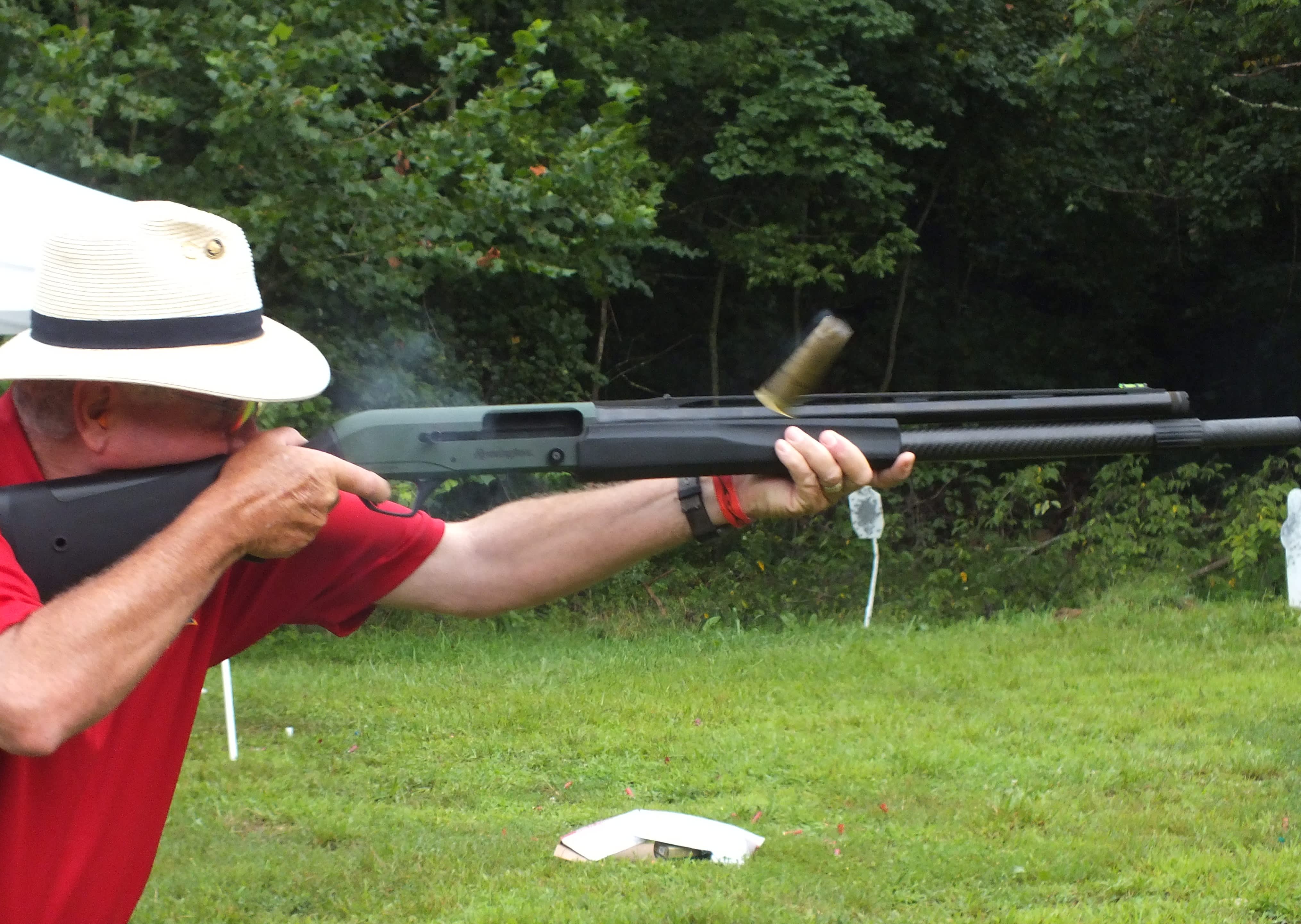Remington VERSA MAX Competition Tactical Shotgun
Lewis Creek Shooting School 09.11.13

Sometimes, the obvious just isn’t that obvious. Since the days of the earliest semiautomatic shotguns, there’s been the issue of a gun’s action managing low-powered and high-powered shells. The problem is that any semiautomatic firearm relies on spring pressure to close the action. If the spring is too strong for the energy of the cartridge, the gun short-cycles and doesn’t eject or load the next cartridge. If the spring is too weak, the bolt slams back and causes the gun to wear prematurely.
The early Browning A5 guns addressed the problem with a friction washer that could be reversed to slow down the recoil energy of high-powered shells. This worked with limited success. The process of changing from low- to high-power shells required partial disassembly of the gun and it only worked with 2-3/4-inch shells. For three-inch magnum shells, you had to buy a different gun that was tuned for the higher-energy load.
Remington and High Standard came up with a better idea for their gas-operated shotguns. They fitted their early designs with a two-position bleed-off port that could be switched in the field without removing any parts. In the High Standard 20 gauge versions, this system even accommodated three-inch shells. Better engineering eventually provided systems balanced enough to manage 2-3/4-inch and three-inch shells in the same gun, but the new 3-1/2-inch shell required buying a different gun that struggled with anything but magnum 2-3/4-inch shells.
Benelli was the next innovator with their inertia-driven system. The Benelli system allowed shooting 2-3/4-inch, three-inch, and 3-1/2-inch shells in the same gun, but light target loads still struggled to fully cycle the action. Still, it was the most versatile system yet. Enter the Remington VERSA MAX Competition Tactical, and “Big Green” has solved the problem forever as far as I am concerned.
I shot the VERSA MAX Competition Tactical first at a writer’s shooting day and I was impressed, but skeptical. I then obtained one for an extended test and that skepticism is now gone. It really works, and it works flawlessly.
The way the gun’s action functions is the interesting part. In the past, the energy to bring the bolt to the rear on gas-operated guns was provided by ports midway down the barrel. The size of these ports and the area of the piston determined the energy driving the bolt to the rear. While the early gas guns bled off some of the gas for higher-powered shells, the VERSA MAX simply blocks off extra gas completely in an ingenious way. On the VERSA MAX, there are a pair of gas pistons just under the chamber area of the barrel. There are seven gas ports and five of those are actually in the chamber. Due to this layout, a three-inch shell “closes off” three ports. A 3-1/2-inch shell closes off five ports, and a 2-3/4-inch shell closes none—using all seven ports to operate the gun. The system is completely passive in that the shell itself determines the amount of energy delivered to the bolt.
With this system, the VERSA MAX will shoot the lightest target load and a 3-1/2-inch magnum duck load in the same magazine load and function perfectly. In fact, my test gun has yet to malfunction and I’ve run hundreds of loads from light to brutal through it and it hasn’t been cleaned yet. In one test, I loaded the magazine with a mixed bag of shells from a 3-1/2-inch 2-1/4-ounce turkey load to a 2-1/2-inch vintage shotgun load of 7/8-ounce. I repeated the test three times and the gun ran perfectly each time.
After the field grades, came the Tactical version of the VERSA MAX with an extended 8+1 capacity magazine and shorter barrel. Now, we have the Competition version. “We started off with our Tactical VERSA MAX and went back to the drawing board and figured how to make the best out-of-the-box 3-gun shotgun in the industry. We designed it as an eight-shot gun and we include a carbon fiber two-shot extension in the box,” said Remington engineer Justin Quackenbush at the recent AR15.com Rockcastle 3 Gun Championship. “We used a single-piece magazine tube and added express dovetail sights so you can bear down and shoot close with slugs or tighter chokes. We opened up the loading port and developed a new carrier that allows faster loading and a smaller chance of snagging a finger. We added a competition safety and an enlarged bolt release.”
The VERSA MAX Competition Tactical can also be ghost-loaded to allow a total of eleven shots. They also added QD swivel attachments in the stock and fore-end. It also comes with comb and length of pull inserts. There are two additional express sights in different heights to allow for differences in sight picture. The VERSA MAX Competition Tactical’s barrel is back-bored for lower recoil and better patterns. This model comes with Pro Bore choke tubes that accommodate the larger bore diameter.
At both the Crimson Trace Midnight 3 Gun and the AR15.com Rockcastle event there were gunners using modified VERSA MAX guns and the modifications they made are now standard on the new gun. I predict this new VERSA MAX is going to become one of the most popular shotguns on the 3-gun circuit—and for good reason.

